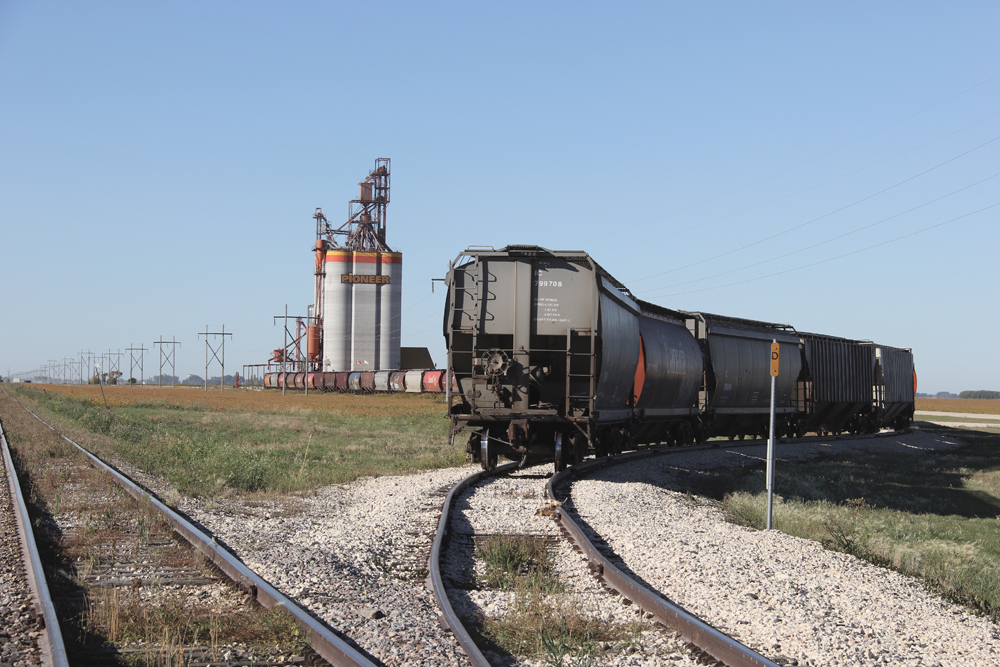Canada’s two main railways keep breaking grain movement records, but oddly, on-time car delivery has fallen compared to the same period last crop year.
It’s counterintuitive, but the explanation is simple: grain companies have ordered 13 per cent more cars this crop year, and the railways, while setting records, aren’t keeping up with the increased demand, according to Ag Transport Coalition (ATC) figures.
The ATC is a coalition of grain companies and farm groups that contracts QGI Consulting to monitor the railways’ grain shipping performance.
Read Also

Mazergroup’s Bob Mazer dies
Mazergroup’s Bob Mazer, who helped grow his family’s company into a string of farm equipment dealerships and the main dealer for New Holland machinery in Saskatchewan and Manitoba, died July 6 from cancer.
From April until the end of the 2019-20 crop year July 31 grain shipping demand was up 21 per cent from the previous year, QGI Consulting’s Milt Poirier said in the shipping week 12 Grain by Train weekly podcast from Pulse Canada.
Why it matters: While grain shipping records are welcome, grain companies emphasize they need to become common as western Canadian farmers keep upping crop production and grain companies are finding markets to take it.
“Normally you would see a slowdown (in grain car orders) in the summer months pre-harvest but that didn’t happen this year, and so far this year (starting Aug. 1) shipper demand is up 13 per cent overall as compared to the same time last year,” Poirier said.
“Over the course of the last six weeks neither railway frankly has performed particularly well, with CN supplying only 77 per cent on average, and CP only 83 per cent of shipper demand on average on a weekly basis. So the trend in performance is downward unfortunately but that’s the trend we have been seeing over the last month and a half.”
Grain shippers say railways are performing well when they deliver 90 per cent of car orders in the week ordered.
Still, both CN and CP set new grain movement records not only for October, but for any month. CN moved 3.27 million tonnes of grain last month, surpassing its previous record of 2.88 million set in October 2019 by 13.5 per cent.
“This unprecedented performance follows seven record months of Canadian grain movement (for CN) in March, April, May, June, July, August, and September,” CN said in a news release.
CP moved three million tonnes in October, breaking its previous movement record set in April by 6.9 per cent.
“It also betters the previous October record of 2.66 million tonnes set in 2019, by 14.2 per cent,” CP said in a news release.
CN and CP set grain movement records in the third quarter (July, August, September) of 2020 moving 7.76 million and 7.72 million tonnes, respectively.
If the railways continue at the current pace they might match or even exceed last year’s record grain movement of 60.7 million tonnes, which broke the previous record of 54.3 million tonnes in 2018-19.
“We should be setting a record every year,” Jeff English, Pulse Canada’s vice-president of marketing and communications, said in an interview Nov. 4. “In fact we have to be setting a record every year because we know farmers are producing more. We know the demand is out there. We know we have ambitious export targets so records being set is an absolute must and is a great news story and it should be an expectation.”
But make no mistake, grain companies aren’t complaining.
“We are getting good service from both CN and CP right now and that’s great for us, that’s great for the farmers, that’s great for the railways and it’s great for Canada,” Wade Sobkowich, executive director of the Western Grain Elevator Association (WGEA), representing the West’s major grain companies, said in an interview Nov. 3.
“We’re pleased to get the capacity and the service that we need right now and we look forward to that continuing into the winter period.”
History has shown winter can throw the railways off schedule because of snow slides and cold temperatures that reduce train sizes.
While the railways can’t change the weather, shippers argue they can prepare better for it.
And sometimes, like last year, blockades arise that the railways have no control over.
Shippers also worry that once the economy begins to rebound traffic from other commodities will sidetrack grain.
Shipping records are welcome, but Sobkowich said the demand to move grain in Canada has never been higher.
“The shippers are testing what the railways can do… ” he said. “If they (grain companies) don’t and their competitor does the competitor is going to get a larger share of the pie. The system is designed to motivate shippers to ask for the top end of what they think they can get.
“We need to move a record amount in order to match the growing crop size in Western Canada… since 2013-14. The railways are adjusting their capacity offering… that’s good and what they should do. They are moving record volumes because farmers are growing record volumes.”
Meanwhile, both railways say they continue to invest to boost capacity.
CP has 3,300 new hoppers out of a commitment for 5,900 laid out in 2018, it said in a news release. The new highly efficient cars carry 15 per cent more grain volume and 10 per cent more weight compared to the older cars they are replacing.
CN said it’s receiving its first shipment of the 1,500 new high-capacity grain cars, with 100 cars received and another 500 expected between now and the end of the year.
Meanwhile, grain companies have invested “literally billions of dollars adding new country elevators and more loop tracks that are more efficient,” Mark Hemmes, president of Quorum Corporation and Canada’s grain monitor, said in an interview Nov. 3.
“The demand for rail service, because of those investments is going to naturally increase. And the railways are responding to it, but not at the rate that demand has increased.”
G3 recently opened a new export terminal in Vancouver and another one, Fraser Grain, is opening soon, he added.
Asked about a possible three-peat in record annual grain shipping, Hemmes said: “I think what we should hope for is that we move as much grain through this year as we did last year without having a panic attack in the middle of winter because something went wrong.
“My concern about talking about another record year is that we’re only three months into the crop year. I’m not a superstitious person but I don’t want to jinx it.”





















